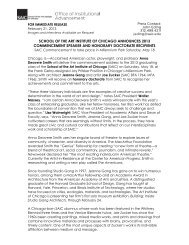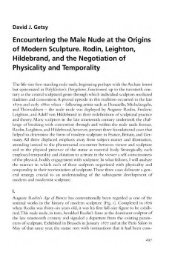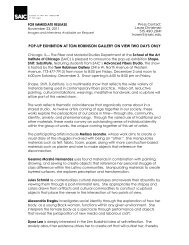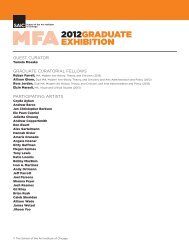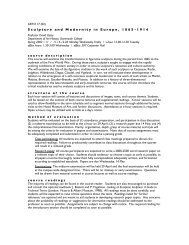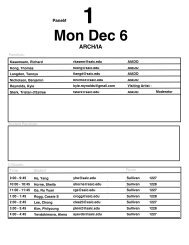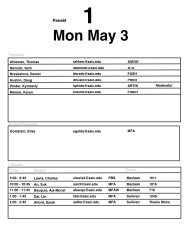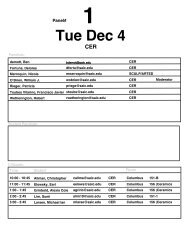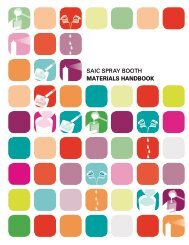i. institutional support and commitment to continuous improvement
i. institutional support and commitment to continuous improvement
i. institutional support and commitment to continuous improvement
Create successful ePaper yourself
Turn your PDF publications into a flip-book with our unique Google optimized e-Paper software.
School of the Art Institute of Chicago<br />
Department of Architecture, Interior Architecture, <strong>and</strong> Designed Objects<br />
Master of Architecture<br />
Master of Architecture with emphasis in Interior Architecture<br />
2) Response <strong>to</strong> student concerns<br />
Program responses <strong>to</strong> student concerns can be discussed by looking at student evaluations,<br />
students representations <strong>and</strong> governance, <strong>and</strong> the role of students in departmental self-assessments.<br />
Student representations <strong>and</strong> governance<br />
In their first semester, students in the MArch program elect two representatives for<br />
each of the two Option II tracks. Those elected representatives remain in place for<br />
the rest of the degree program. With the full implementation of all three years of the<br />
MArch curriculum in Fall 2008, this produced a group of twelve (12) elected student<br />
representatives. These elected representatives from each curricular level are encouraged<br />
<strong>to</strong> bring their class’s concerns <strong>to</strong> the Administrative Direc<strong>to</strong>r <strong>and</strong> the Program Direc<strong>to</strong>r.<br />
They do so regularly because they know this direct, purposeful contact is legitimated,<br />
expected, <strong>and</strong> common at SAIC. This is a quick, effective, <strong>and</strong> primary way for the<br />
institution <strong>to</strong> listen <strong>to</strong> student concerns <strong>and</strong> make appropriate responses. It is the most<br />
common procedure at the School, <strong>and</strong> is used at all administrative levels. Recent examples<br />
of concerns resolved in this way include:<br />
o A concern that some first semester MArch students were at risk of falling seriously<br />
behind the rest of their classmates was reported <strong>to</strong> the program direc<strong>to</strong>r <strong>and</strong> taken<br />
directly <strong>to</strong> the Dean’s Cabinet. A decision was made <strong>to</strong> provide a limited number of<br />
specially selected personal tu<strong>to</strong>rs for students. This service was offered <strong>to</strong> students<br />
who privately <strong>and</strong> individually identified themselves as being at risk <strong>and</strong> in need of the<br />
tu<strong>to</strong>ring. This tu<strong>to</strong>ring is provided free by the Deans’ Office <strong>to</strong> each student during the<br />
first semester for up <strong>to</strong> 30 hours per student. The program has also added a pre-requisite<br />
of algebra <strong>and</strong> physics <strong>to</strong> the MArch programs.<br />
o A concern that students studying structures in the ARCH/INARC 5113 Construction<br />
Systems <strong>and</strong> Structures 1 <strong>and</strong> ARCH/INARC 5123 Matter <strong>and</strong> Structures 2 classes were<br />
spread <strong>to</strong>o widely along the learning curve, because some were not adequately prepared<br />
in the use of algebra at the time of admission, <strong>and</strong> some were not learning structural<br />
concepts as quickly as the rest of the members of the class. This was reported <strong>to</strong> the<br />
Program Direc<strong>to</strong>r who consulted with the structural engineers in those classes. A second,<br />
shorter class session was offered on Friday afternoon, increasing contact time <strong>to</strong> enable<br />
more advice <strong>and</strong> personal guidance <strong>to</strong> any student who needed it.<br />
As of the 2009–10 academic year many student governance <strong>and</strong> communication procedures have<br />
fallen under the purview of the newly re-formed <strong>and</strong> recognized AIAS chapter. With help from the<br />
AIADO administrative office, the chapter organizes two meetings per term with the AIADO program<br />
direc<strong>to</strong>rs, the AIAS officers, <strong>and</strong> student representatives from the MArch program. Of the two<br />
meetings, one is reserved for a discussion <strong>and</strong> feedback on curricula; the other for a discussion <strong>and</strong><br />
feedback on the AIADO learning environment. Other department <strong>support</strong>ed AIAS events for the<br />
2010–2011 academic year include:<br />
Scheduled events<br />
o The Second Beaux Arts Ball <strong>to</strong> be held this spring in SAIC Ballroom. The Beaux Arts<br />
Ball is a time-honored celebration, originating at the École Nationale Supérieure des<br />
Beaux Arts in Paris.<br />
o Professional Dinners: A series of dinners, <strong>to</strong> be held over the course of the year,<br />
with members of the Chicago architecture community. Topics of discussion may include<br />
portfolio reviews, technology <strong>and</strong> environmental impacts.<br />
o Design Competitions: Pulling from national <strong>and</strong> local competitions, the chapter<br />
announced <strong>and</strong> proposes competitions, such as: Delta Faucet Designers of Tomorrow<br />
Architecture Program Report | 20



